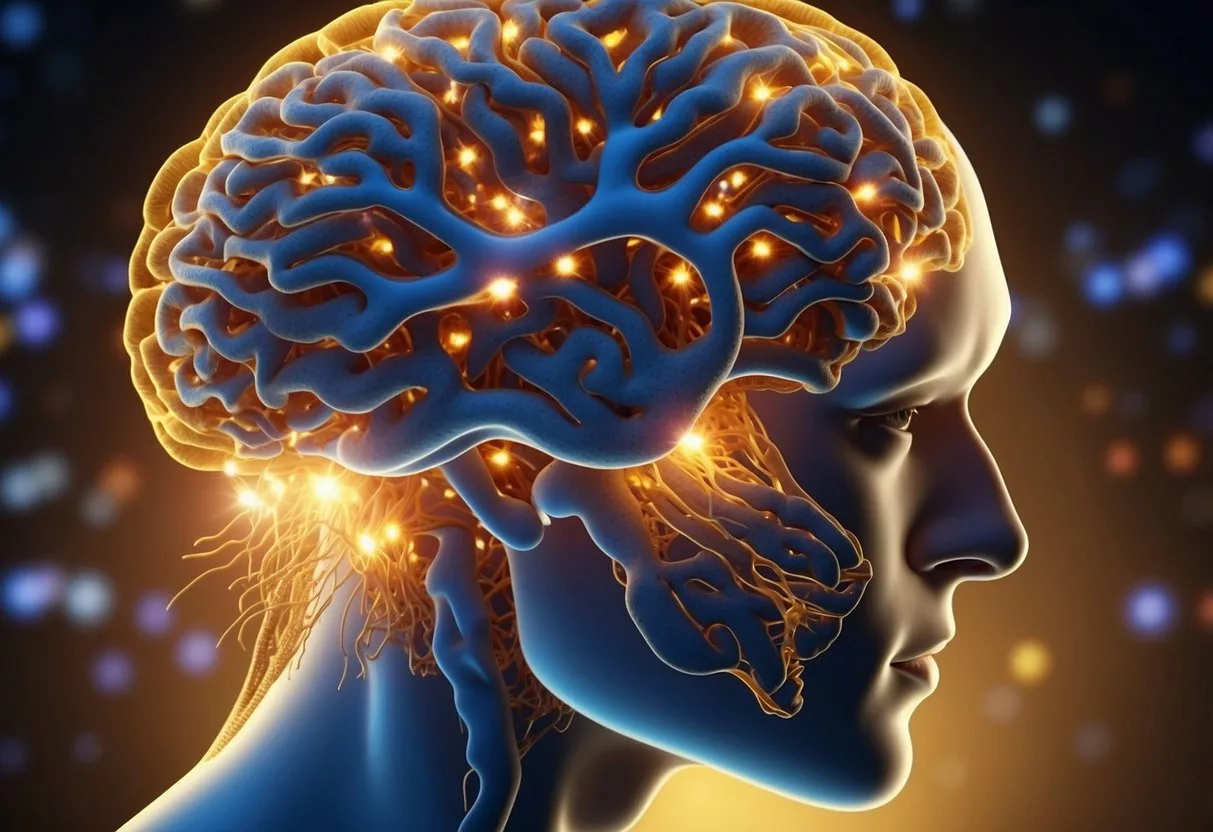When people fall in love, their bodies undergo significant changes. Love affects the brain by activating the limbic system and reward centers, releasing chemicals like dopamine and oxytocin that create feelings of happiness and attachment. This can make hearts race, palms sweat, and butterflies flutter in the stomach.

Love also impacts physical health. For instance, it can lower blood pressure and reduce stress, making for a healthier heart and body. Oxytocin, often known as the “love hormone,” plays a crucial role in strengthening bonds and increasing feelings of trust and connection.
Emotionally, being in love can make individuals feel more secure and happy. It encourages behaviors like increased affection and care. These feelings and actions are deeply rooted in human evolution and psychological well-being, reflecting our innate desire to form lasting relationships.
Key Takeaways
- Love releases chemicals that boost happiness and attachment.
- Physical health benefits from reduced stress and lower blood pressure.
- Loving relationships foster emotional security and trust.
The Science of Love

When a person falls in love, their body undergoes a variety of complex processes. These include changes in hormone levels, increased activity of certain neurotransmitters, and activation of specific brain regions.
Hormonal Responses
Hormones play a crucial role in the experience of love. Three key hormones involved are dopamine, oxytocin, and vasopressin.
Dopamine, often called the “feel-good” hormone, increases in response to pleasurable activities. In love, dopamine levels rise, creating feelings of happiness and excitement. This response is similar to how the brain reacts to certain drugs, highlighting love’s powerful effect.
Oxytocin, known as the “love hormone,” enhances bonding and trust. It’s released during physical contact like hugging or kissing, strengthening emotional connections. Vasopressin, another important hormone, supports long-term attachment and monogamous relationships.
In addition to these hormones, love can also influence heart rate and stress levels. The presence of a loved one tends to lower stress, contributing to overall well-being.
Neurotransmitter Activity
Neurotransmitters are chemicals that transmit signals in the brain. They are pivotal in the science of love.
Key neurotransmitters involved in love include dopamine and serotonin. Dopamine is associated with pleasure and reward, while serotonin impacts mood and appetite. In the early stages of love, dopamine spikes, resulting in intense feelings of euphoria.
Oxytocin and vasopressin, though technically hormones, also act as neurotransmitters in the brain. They enhance attachment and bonding, facilitating long-term relationships.
The vagus nerve also plays a role by connecting the brain to the heart, impacting emotional responses and physical sensations.
Brain Regions Involved in Love
Specific brain regions are activated when a person falls in love. The limbic system, responsible for emotions and memory, plays a significant role. Within this system, the amygdala processes emotions, while the hippocampus is involved in forming new memories.
The ventral tegmental area (VTA) and the basal ganglia are critical for reward and pleasure responses. These areas release dopamine, creating the high associated with being in love.
The prefrontal cortex, which is involved in decision-making and social behavior, also sees increased activity. This highlights love’s impact on both emotional and cognitive processes.
The frontal cortex helps in regulating emotions and making judgments about the feelings of others.
These brain activities collectively explain why love has such a profound effect on behavior and emotions.
Physical Effects of Love

Love impacts the body in multiple ways, influencing the cardiovascular system, neuroendocrine functions, and the immune response.
Cardiovascular Changes
When people fall in love, their heart rate increases, and blood pressure can fluctuate. This happens due to a surge in hormones like adrenaline and dopamine, making the heart pump faster. These changes can make someone feel as if their heart is fluttering or racing.
Heart rate and blood pressure reactions are common physical manifestations. The release of dopamine and norepinephrine stimulates the nervous system, leading to heightened alertness and more energy. This cardiovascular response is similar to how the body reacts in stressful or thrilling situations. Over time, this heightened state can affect long-term heart health.
Neuroendocrine Effects
Love triggers the release of several hormones, including oxytocin, often called the “love hormone.” Oxytocin is related to bonding and affectionate behavior. High levels of this hormone are noticed during physical touch, hugs, and sexual activity. It helps reduce stress by lowering the stress hormone cortisol, promoting a sense of well-being.
Dopamine levels also surge, influencing feelings of pleasure and reward. This neuroendocrine effect keeps the emotional connection strong and enhances mood. In addition, sex hormones like estrogen and testosterone play a role in libido and overall physical health. These hormonal changes can lead to a motivated and positive state of mind.
Immune and Pain Response
The immune system appears to benefit from the positive emotions associated with being in love. Elevated mood and reduced stress levels contribute to better immune health and resilience. The overall improvement in well-being can boost the body’s ability to fend off illnesses.
Pain relief is another effect. Love increases the levels of endorphins, natural painkillers produced by the body. Oxytocin, aside from its bonding effects, also acts as an analgesic, reducing pain perception. These combined effects mean that individuals in love often experience less physical pain and discomfort, enhancing their overall health and quality of life.
These factors together explain the profound physiological changes that love brings about, affecting numerous aspects of health and well-being.
Emotional and Behavioral Responses

When people fall in love, they experience many changes in their emotions and behaviors. These changes include stronger feelings of attachment, increased motivation, and heightened anxiety.
Feelings of Attachment and Security
Love often creates feelings of attachment and security. These feelings are closely tied to the release of oxytocin, also known as the “love hormone.” Oxytocin promotes bonding and trust, making individuals feel safe and secure with their partners.
People in love tend to think about their partners frequently. This mental focus helps strengthen their emotional connection. They may also behave more affectionately, showing more care and concern. Overall, the attachment helps build a strong, supportive relationship that can reduce feelings of loneliness and increase a sense of well-being.
Desire and Motivation
Falling in love often boosts desire and motivation. This is driven by the brain’s dopamine system, which reinforces pleasurable feelings. Dopamine makes individuals feel excited and energized when they think about or are with their loved one.
This increased desire can lead to changes in behavior. People might go out of their way to spend more time with their partner or engage in activities that their partner enjoys. They may also work harder to improve themselves, aiming to be the best version of themselves. This drive adds excitement and purpose to their lives.
Stress and Anxiety
Interestingly, love can trigger both stress and anxiety. When people first fall in love, their cortisol levels often rise. Cortisol is a stress hormone, and its increase can put the body into a heightened state of alertness.
This can lead to feelings of nervousness or anxiety, especially in the early stages of a relationship when everything is new and uncertain. Over time, as the relationship becomes more stable, these stress levels usually decrease. The initial anxiety gives way to feelings of security and calm, due to the trust and bond that develop between partners.
Social and Evolutionary Implications

Love isn’t just a feeling but a complex set of behaviors and responses that have significant social and evolutionary benefits, impacting relationship formation, reproduction, and overall life satisfaction.
Relationship Formation and Development
When people fall in love, a variety of biological and psychological processes encourage the formation and deepening of social bonds. Romantic relationships[1] are often driven by a combination of physical attraction, emotional passion, and the desire for commitment. Chemical changes in the brain like the release of dopamine and oxytocin create feelings of pleasure and attachment, reinforcing connections.
These bonds are essential for developing long-term partnerships and friendships. The social support that comes with a committed relationship can enhance emotional wellbeing and reduce feelings of loneliness. Marriages and long-term partnerships also provide stability and support for raising children, making them a crucial part of human social structure.
Fertility and Reproduction
Love and sexual attraction play vital roles in reproduction. The chemistry of love, particularly the activation of reward centers in the brain, encourages individuals to seek out and maintain romantic relationships that are conducive to reproduction[2]. The experience of passion and desire, driven by hormones such as testosterone and estrogen, increases the likelihood of procreation.
In many species, including humans, these biological mechanisms ensure the continuation of the species. By fostering strong bonds between mates, love increases the chances of cooperative parenting, which is beneficial for the survival and wellbeing of offspring. Human connection and shared responsibilities can lead to better care and nurturing of children.
Longevity and Life Satisfaction
Being in a loving relationship is often linked to longer life and enhanced life satisfaction. Studies indicate that strong, healthy relationships can reduce stress, lower the risk of chronic diseases, and improve overall health. This is because the support and companionship found in romantic relationships help mitigate life’s challenges and stressors.
Moreover, the presence of a committed partner provides emotional security, increasing an individual’s sense of wellbeing and happiness. The consistency and reliability of a supportive partner can enhance life satisfaction and promote longevity, making love not just a fleeting emotion but a vital component of human life and health. Longevity[3] in love can thus be seen as both a biological and social benefit.
Psychological Perspectives

Falling in love triggers complex changes in both the brain and body, influencing emotional intelligence, mental health, and sometimes leading to addiction-like behaviors. These changes can profoundly affect how a person feels, thinks, and acts.
Emotional Intelligence in Love
Emotional intelligence plays a key role in navigating romantic relationships. When individuals are in love, they often experience heightened empathy and connectedness. This increased awareness helps them anticipate their partner’s needs and respond more appropriately.
Oxytocin and Intimacy: This hormone boosts trust and intimacy, making couples feel more bonded. The mirror neuron system[4] helps partners understand each other’s emotions, leading to better communication and deeper connection.
Decision-Making: Love enhances emotional regulation, allowing individuals to handle relationship challenges more effectively. This can lead to improved decision-making, both within the relationship and in other areas of life.
Impact on Mental Health
Love can have both positive and negative effects on mental health. On one hand, being in a loving relationship often brings about feelings of euphoria and motivation, leading to increased levels of life satisfaction.
Positive Effects: Happy relationships can reduce stress, enhance happiness, and lower the risk of depression. The release of oxytocin[5] also contributes to a sense of well-being and security.
Potential Pitfalls: On the downside, intense romantic feelings can sometimes lead to obsessive-compulsive behaviors or jealousy. Unrequited love or breakups can result in significant emotional pain, potentially triggering mental health issues like depression or anxiety.
Love and Addiction
The brain’s reward system is highly active when a person is in love. Areas like the limbic system and reward centers are flooded with dopamine, creating a sensation of pleasure and reward similar to that experienced with addictive substances.
Dopamine Rush: This chemical surge can lead to feelings of joy and excitement, much like a high. The intense emotions experienced during the initial stages of love can make it difficult to focus on anything else.
Addiction-Like Behavior: The term “love addiction” arises because some individuals crave the euphoric state that love brings, leading to compulsive behaviors to achieve this feeling. This can sometimes result in unhealthy attachment or dependency on their partner.
Understanding these psychological aspects can help in managing relationships better while recognizing the thin line between healthy love and potentially harmful behaviors.
Frequently Asked Questions

Falling in love causes various physical and emotional changes in the body. It affects heart rate, brain chemistry, and even blood pressure. Here are some common questions and detailed answers about the physical and emotional impacts of love.
What physical changes occur in the body when someone falls in love?
When someone falls in love, their heart rate increases, and they may feel like their heart is racing. This is because of the release of adrenaline and other hormones. Additionally, dopamine and oxytocin[6] are released, which promote feelings of pleasure and attachment.
How does falling in love impact one’s emotional state?
Falling in love generally leads to heightened emotions. People often experience joy, excitement, and a sense of euphoria. This is largely due to the increased levels of serotonin and dopamine in the brain, which enhance mood and emotional well-being. It creates a powerful emotional connection with the person they are in love with.
What are the negative psychological effects associated with falling in love?
Though love is often joyous, it can also lead to stress and anxiety. The increase in cortisol levels during love can cause the body to go into a mild fight-or-flight response. This can lead to sleeplessness, nervousness, and even obsessive thoughts about the loved one.
How is a woman’s body affected during the process of falling in love?
Women experience similar hormonal changes as men, including increased levels of oxytocin, which plays a key role in bonding and emotional connection. Oxytocin helps women feel more connected and trusting. Additionally, their heart rates and energy levels may also increase due to the adrenaline rush.
What are the physiological responses when one feels love or heartbreak?
When in love, the body releases hormones like oxytocin and dopamine, contributing to feelings of happiness and attachment. Heartbreak, on the other hand, leads to a decrease in these feel-good hormones and an increase in stress hormones. This can cause symptoms like elevated heart rate, loss of appetite, and even physical pain.
How can you identify the physical signs of someone falling in love?
Physical signs include an increased heart rate, flushed cheeks, and dilated pupils. People often smile more and may feel a burst of energy when around the person they love. These changes are due to the body’s release of hormones like dopamine and oxytocin, which enhance feelings of pleasure and attachment.
References
- What happens in our brain and body when we’re in love?. https://theconversation.com/what-happens-in-our-brain-and-body-when-were-in-love-198885 Accessed November 5, 2025
- 15 Effects of Love on Your Brain and Body. https://www.healthline.com/health/relationships/effects-of-love Accessed November 5, 2025
- Love and the Brain. https://hms.harvard.edu/news-events/publications-archive/brain/love-brain Accessed November 5, 2025
- What happens in your brain when you’re in love?. https://www.apa.org/topics/marriage-relationships/brain-on-love Accessed November 5, 2025
- oxytocin. https://themindsjournal.com/what-happens-to-your-body-when-you-fall-in-love/ Accessed November 5, 2025
- The Science Of Love: What’s Happening in Your Body. https://www.nm.org/healthbeat/healthy-tips/emotional-health/the-science-of-love Accessed November 5, 2025
